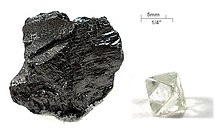What does atomic number 6 mean?
Definitions for atomic number 6
atomic number 6
This dictionary definitions page includes all the possible meanings, example usage and translations of the word atomic number 6.
Princeton's WordNet
carbon, C, atomic number 6noun
an abundant nonmetallic tetravalent element occurring in three allotropic forms: amorphous carbon and graphite and diamond; occurs in all organic compounds
Wikipedia
atomic number 6
Carbon (from Latin carbo 'coal') is a chemical element with the symbol C and atomic number 6. It is nonmetallic and tetravalent—its atom making four electrons available to form covalent chemical bonds. It belongs to group 14 of the periodic table. Carbon makes up about 0.025 percent of Earth's crust. Three isotopes occur naturally, 12C and 13C being stable, while 14C is a radionuclide, decaying with a half-life of about 5,730 years. Carbon is one of the few elements known since antiquity.Carbon is the 15th most abundant element in the Earth's crust, and the fourth most abundant element in the universe by mass after hydrogen, helium, and oxygen. Carbon's abundance, its unique diversity of organic compounds, and its unusual ability to form polymers at the temperatures commonly encountered on Earth, enables this element to serve as a common element of all known life. It is the second most abundant element in the human body by mass (about 18.5%) after oxygen.The atoms of carbon can bond together in diverse ways, resulting in various allotropes of carbon. Well-known allotropes include graphite, diamond, amorphous carbon and fullerenes. The physical properties of carbon vary widely with the allotropic form. For example, graphite is opaque and black while diamond is highly transparent. Graphite is soft enough to form a streak on paper (hence its name, from the Greek verb "γράφειν" which means "to write"), while diamond is the hardest naturally occurring material known. Graphite is a good electrical conductor while diamond has a low electrical conductivity. Under normal conditions, diamond, carbon nanotubes, and graphene have the highest thermal conductivities of all known materials. All carbon allotropes are solids under normal conditions, with graphite being the most thermodynamically stable form at standard temperature and pressure. They are chemically resistant and require high temperature to react even with oxygen. The most common oxidation state of carbon in inorganic compounds is +4, while +2 is found in carbon monoxide and transition metal carbonyl complexes. The largest sources of inorganic carbon are limestones, dolomites and carbon dioxide, but significant quantities occur in organic deposits of coal, peat, oil, and methane clathrates. Carbon forms a vast number of compounds, with almost ten million compounds described to date, and yet that number is but a fraction of the number of theoretically possible compounds under standard conditions.
ChatGPT
atomic number 6
The atomic number 6 refers to the chemical element Carbon. The atomic number in an element is determined by the number of protons in its nucleus, and Carbon has 6 protons. Hence, its atomic number is 6. Carbon is a key component of all known life on Earth, representing approximately 45-50% of all dry biomass. It is also a major element in many minerals and in the complex molecules that make up proteins, fats, sugars, and other life-related substances.
Matched Categories
Numerology
Chaldean Numerology
The numerical value of atomic number 6 in Chaldean Numerology is: 8
Pythagorean Numerology
The numerical value of atomic number 6 in Pythagorean Numerology is: 8
Translations for atomic number 6
From our Multilingual Translation Dictionary
- número atómico 6Spanish
- nguyên tử số 6Vietnamese
- 原子序数6Chinese
Get even more translations for atomic number 6 »
Translation
Find a translation for the atomic number 6 definition in other languages:
Select another language:
- - Select -
- 简体中文 (Chinese - Simplified)
- 繁體中文 (Chinese - Traditional)
- Español (Spanish)
- Esperanto (Esperanto)
- 日本語 (Japanese)
- Português (Portuguese)
- Deutsch (German)
- العربية (Arabic)
- Français (French)
- Русский (Russian)
- ಕನ್ನಡ (Kannada)
- 한국어 (Korean)
- עברית (Hebrew)
- Gaeilge (Irish)
- Українська (Ukrainian)
- اردو (Urdu)
- Magyar (Hungarian)
- मानक हिन्दी (Hindi)
- Indonesia (Indonesian)
- Italiano (Italian)
- தமிழ் (Tamil)
- Türkçe (Turkish)
- తెలుగు (Telugu)
- ภาษาไทย (Thai)
- Tiếng Việt (Vietnamese)
- Čeština (Czech)
- Polski (Polish)
- Bahasa Indonesia (Indonesian)
- Românește (Romanian)
- Nederlands (Dutch)
- Ελληνικά (Greek)
- Latinum (Latin)
- Svenska (Swedish)
- Dansk (Danish)
- Suomi (Finnish)
- فارسی (Persian)
- ייִדיש (Yiddish)
- հայերեն (Armenian)
- Norsk (Norwegian)
- English (English)
Word of the Day
Would you like us to send you a FREE new word definition delivered to your inbox daily?
Citation
Use the citation below to add this definition to your bibliography:
Style:MLAChicagoAPA
"atomic number 6." Definitions.net. STANDS4 LLC, 2024. Web. 27 Apr. 2024. <https://www.definitions.net/definition/atomic+number+6>.



Discuss these atomic number 6 definitions with the community:
Report Comment
We're doing our best to make sure our content is useful, accurate and safe.
If by any chance you spot an inappropriate comment while navigating through our website please use this form to let us know, and we'll take care of it shortly.
Attachment
You need to be logged in to favorite.
Log In